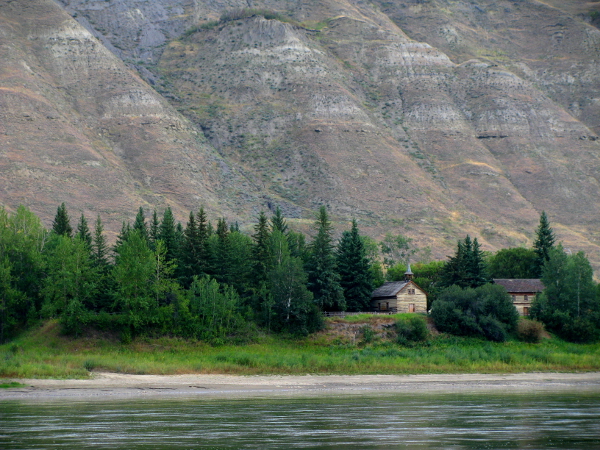Welcome back to the Rewilding Our Rivers Discussion Series. Today we will look at the role of the floodplain and the importance of designing systems that support the meandering wishes of our rivers.
A floodplain is the flat area of land along a river or stream that is subject to flooding. The width of the floodplain is dependent on the meandering amplitude of the river. It is essentially the breathing room for a river or a stream to meander, overflow, re-route and change course. Rivers will flow where they want and the floodplain is there to provide space for the river to move.
The ecosystem of the floodplain consists of native grasses, woodlands, wetlands and riparian zones. The establishment of rooted vegetation helps to absorb the force as well as the volume of rising floodwaters. The vegetation also serves to stabilize bank erosion, filter pollutants and provide habitat for animals and recreational spaces for humans. Development of impervious surfaces on the floodplain such as buildings, roads and parking lots hinder the ability of the floodplain to absorb floodwaters and at the same time speeds up runoff into streams leading to increased downstream flooding.
Historically, cities and towns have been built on floodplains adjacent to water bodies for practical reasons like access to fresh water, cheap transportation routes and the fertility of land for farming. These historical settlement patterns have naturally evolved and human development on the floodplain has increased as cities and towns continue to grow. Subsequently, this development has led to greater encroachment on the vegetated landscapes of the floodplain. Without intending, the way we have chosen to develop has created a growing vulnerability in the face of flooding. The river no longer has the breathing room to choose its course without highly impacting our contemporary settlements.
We are also learning that how we have developed, and continue to develop our land, can exacerbate our vulnerability in the face of floods. This has led flood mitigation experts to turn to land use practise, planning and stewardship as one possible solution for flood mitigation.
 |
| “Peace River Special” by Dru! is licenced under CC BY 2.0. No changes were made to this photo. |
Some champion relocation of highly vulnerable communities out of the floodplain in order to give the river room to move in the event of a flood. We have seen this in Lethbridge after the 1953 flood event, when the city decided to move the Colabanks community out of the floodplain and develop new communities with 100 year flood line in mind[1]. Likewise, after the Big Thompson Flood of 1976, which claimed 143 lives, the city of Boulder, Colorado adopted similar measures. Boulder began relocating properties, along with hazard structures like gas stations and water treatment facilities out of the floodway. Boulder bought 48,000 acres of floodplain land that was turned into green space for recreation – and in the event of a flood, to provide the river room to meander. This coupled with softer engineered solutions like the construction of bike paths that turn into underground water channels for the river to run, were measures that greatly mitigated the impacts of the 2013 flood event[2].
In the United Kingdom (UK), alternative flood mitigation efforts focus more on the regeneration of the floodplain. Flood mitigation efforts in the UK recognize the impact the depletion of soils, woodlands and wetlands has had on the likelihood of a major flooding event. For example, recent discoveries show that water sinks into the soil under trees 67 times the rate at which it sinks into the soil under grasses[3]. Proponents of floodplain regeneration in the UK argue for more innovative land use solutions through farm payments and incentives to landowners to restore woodlands, grasslands and wetlands in order to re-naturalize rivers[4].
Research is currently underway in one region in the UK, where a 5% reforestation of lands in the Pontbren region reduced peak flood flows downstream by 29%. This research that has led scientists to believe that full reforestation of the Pontbren region would reduce peak flows by 50%, subsequently solving the issue of flooding for residents of Shrewbury, Gloucester and other towns downstream[5]. These examples from around the world demonstrate the effectiveness softer solutions, like the reforestation of floodplains, could play in Alberta’s future flood mitigation plans.
We cannot change the past. We have chosen to set up camp and establish communities on the banks of our waterways. We need to take a step back and accept the reality that we have settled in areas that have risks associated with them. The challenge now rests with how we can create space for the river to breathe. Now is not the time to think we can control where the river wants to go; ultimately the river will choose its course. It is up to us to ensure the river has room to meander. Luckily the tide is turning, and research is showing that innovative light touch solutions, such as farm incentives that encourage re-vegetation of the floodplains, or green spaces to sacrifice in the event of a flood, are effective flood mitigation measures. Recognizing these solutions and their effectiveness is critical as we continue on this journey to look at the best possible flood mitigation efforts for generations of Albertans to come.
Lauren Eden is a Researcher at Alberta WaterSMART
[1] Zentner, C. (2013, August 23). Foresight needed to prevent further flood grief. Lethbridge Herald. Retrieved fromhttp:/lethbridgeherald.com/news/local-news/2013/08/foresight-needed-to-prevent-further-flood-grief/
[2] Doig, W & Still Life Projects. (2014).You can’t stop urban flooding. Retrieved from http://nextcity.org/forefront/view/you-cant-stop-urban-flooding
[3] Monbiot, G. (2014, January 13). Drowning in money: The untold story of the crazy public spending that makes flooding inevitable. The Guardian. Retrieved from http://www.theguardian.com/commentisfree/2014/jan/13/flooding-public-spending-britain-europe-policies-homes?CMP=twt_fd
[4] http://www.theguardian.com/commentisfree/2014/feb/05/how-to-stop-flooding-soil-water-farming-dredging
[5] Juniper, T. (2014, February 5). How to really stop flooding. The Guardian. Retrieved from http://www.theguardian.com/commentisfree/2014/jan/13/flooding-public-spending-britain-europe-policies-homes?CMP=twt_fd
